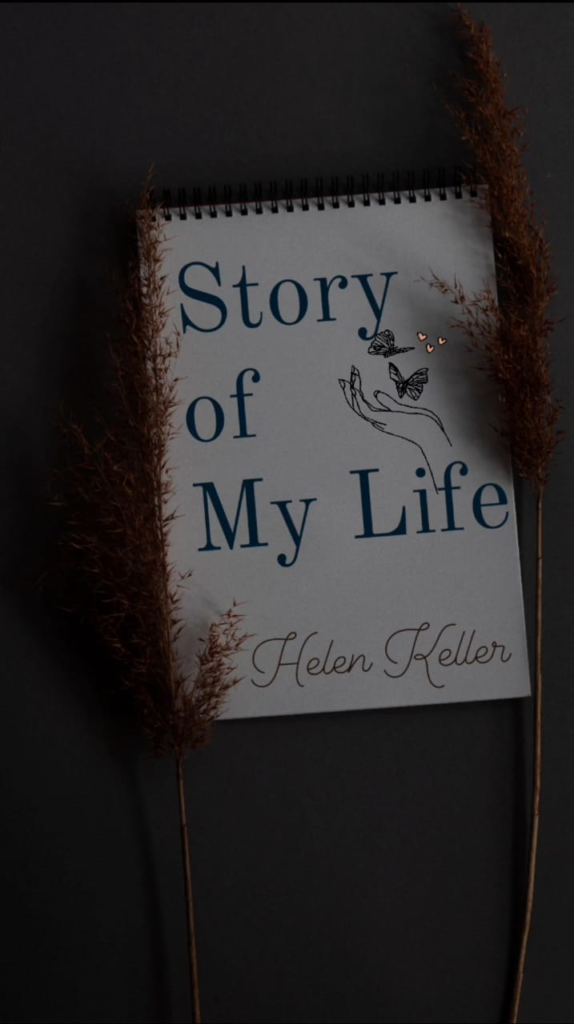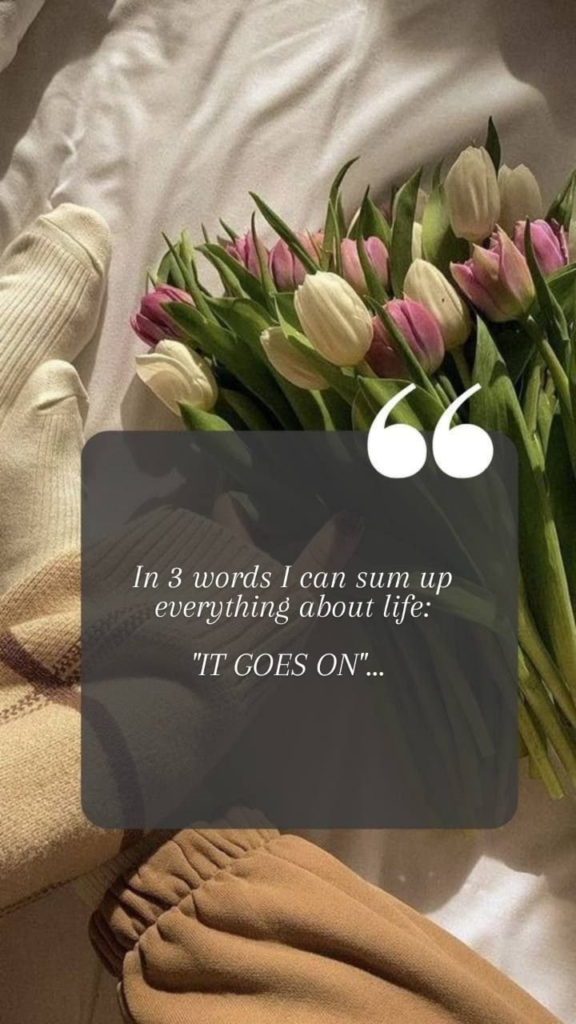“Some good , some bad but something interesing this is the story of my life”
Helen Keller wrote the autobiographical book “The Story of My Life” in 1903. It tells the story of Keller’s life from when she was a baby until she was 22 years old, including how she dealt with a serious illness and eventually overcame her blindness and deafness with the help of her teacher, Annie Sullivan. The book has become a classic, and Keller’s bravery and determination in the face of great obstacles have inspired millions.
Book Highlights
PART ONE : STORY OF MY LIFE Book

Story of my life Helen Keller was born in the small Alabama town of Tuscumbia on June 27, 1880. She was diagnosed with a disease that left her blind and deaf when she was a year old. It was difficult for her to communicate, even with her family, in the early years after her illness; she lived her life entirely in the dark, often angry and frustrated that no one could understand her. Everything changed in March 1887, when Helen’s teacher, Anne Sullivan, came to live with the family in Alabama and completely transformed Helen’s life.
Miss Sullivan taught Helen how to name objects by handing them to her and then spelling out the letters in her hand. Helen learned to spell these words by imitation, without realizing what she was doing, but she eventually realized that everything had a name and that Miss Sullivan was teaching her. Helen picked up language quickly after that; she especially enjoyed learning in nature, where she and her teacher would go for walks and she would ask questions about her surroundings. Helen soon learned to read, thanks to Miss Sullivan, who taught her by giving her strips of cardboard with raised letters on them and then having her act out the sentence with objects.
Helen traveled to Boston with her mother and teacher in May 1888. She studied at the Perkins Institute for the Blind for a while and quickly made friends with the other blind girls her age. They took a vacation to Brewster, Cape Cod, where Helen saw the ocean for the first time. They spent nearly every winter after that up north. Helen was determined to learn to speak after she had learned to read. Her teacher and many others thought it was impossible for her to ever speak normally, but she was determined to get there. Helen learned by feeling the position of Miss Fuller’s lips and tongue when she spoke, thanks to Miss Sullivan’s introduction to the Horace Mann School in 1890. Her first words, “It is warm,” were a powerful memory for her: she was overjoyed that she might finally be able to communicate with her family and friends.

Helen had a difficult time during the winter of 1892. She wrote “The Frost King,” apparently inspired by the beautiful fall foliage around her, and sent it up to her teacher at the Perkins Institute as a gift. Helen’s story was soon discovered to be very similar to another in a published book called “The Frost Fairies.” Helen had read the original story of my life as a child, and the words had become so ingrained in her mind that she had unwittingly plagiarized them when she wrote her own. Mr. Perkins, Helen’s Perkins Institute teacher, Helen’s relationship with Mr. Nagnos, was tainted as a result, and she began to doubt her own mind and the originality of her thoughts for a long time.
Helen began her formal education at the Wright-Humason School for the Deaf in New York City in 1894, where she studied history, Latin, French, German, and arithmetic. In 1896, she enrolled at the Cambridge School for Young Ladies in Massachusetts, where she would later attend Radcliffe College, a women’s college affiliated with Harvard University. It was her first time at school with girls who could see or hear, rather than students who were also deaf or blind.
Her mother eventually withdrew her from the Cambridge School to finish her Radcliffe preparation with a private tutor because they did not agree with the Cambridge School principal’s desire to lighten Helen’s course load. She qualified for Radcliffe in 1899 and began college in the fall of 1900. Helen valued her opportunity to attend college despite the fact that it presented her with unique challenges. Helen uses the final chapters of her memoir to talk about things that are important to her, such as her love of books, her favorite pastimes, and the friends she made who shaped her life. Helen’s personal letters written throughout her youth are included in two additional sections of the autobiography, as well as supplementary commentary by her editor and a first-hand account by Helen’s teacher, Anne Sullivan.
PART TWO : STORY OF MY LIFE Book

Part two of The Story of My Life book is a collection of letters written by Helen Keller throughout her education. It begins with an introduction by the editor, who explains that these letters are included not only to add detail to her life story, but also to demonstrate her growth in thought and expression over the course of her education. Helen wrote a lot of letters because she moved around the country a lot and lived in different parts of it. As a result, she had to write a lot in order to stay in touch with her friends and family.
The majority of these letters are also of very high writing quality, as many of Helen’s friends were distinguished people to whom she felt she needed to write well in order to maintain their respect. The letters in this section of the memoir are a selection from the hundreds she wrote and are organized chronologically.
Helen’s first letter was written three and a half months after Miss Sullivan arrived and began teaching her. On June 17, 1887, it was given to her cousin Anna. This letter, like all of Helen’s early ones, is barely understandable, written without punctuation and filled with strings of simple phrases. According to an editor’s comment, these penciled letters were also difficult to read due to her illegible handwriting. Helen’s sentence construction improved the following fall when she sent letters to the Perkins Institute’s blind children as well as Mr. Anagnos, when she was able to use full sentences and experiment with punctuation.
Adjectives first appear in her letters to her friends in early 1888, when she mentions her upcoming summer trip to Boston. She still does not conjugate verbs correctly, but her letters are more detailed and easy to understand. She writes to Mr. Anagnos frequently, and in one of her letters to him, she describes Miss Sullivan’s dedication to teaching her: while she was at a picnic with other children, Miss Sullivan took her for a walk while describing the nearby trees for her.
Helen spends a lot of her letters telling about the lessons she’s learned, including her first history lesson about pilgrims from her trip to Plymouth, Massachusetts. By the beginning of 1889, Helen’s grammar had greatly improved, and her writing was on par with—if not better than—that of any girl her age. Dr. Edward Everett Hale, a distant cousin, is another friend to whom Helen writes frequently; she tells him about her and her family’s lives.

Miss Sullivan is away from Helen for three and a half months in the summer of 1889, the first time they have ever been apart. Only once in the next fifteen years would the two be apart for more than a few days. While she is away, Helen writes to Miss Sullivan, telling her what is going on at home and how often she thinks of her. Helen wrote home to her little sister Mildred in the fall of 1889, taking care to phrase the letter in simple sentences that her young sister would understand. She informs her about what she is learning in school. At one point, she writes to an unknown poet named John Greenleaf Whittier, telling him that his poems make her very happy.
Helen writes to her friend Reverend Phillips Brooks in the summer of 1890, asking him to tell her something he knows about God. He responds with a warm letter in which he tells Helen that God is there to speak to her if she listens, as long as she values goodness and love. She corresponds with Dr. Oliver Wendell Holmes on a few occasions, and according to her letters, he comments on how well she has mastered language.
Helen writes to her mother, Kate, every time she visits Boston, and in one letter she describes the landscape outside the window on her train journey with beautiful, articulate prose; She once said of the hills in Virginia, “Jack Frost had dressed them in gold and crimson.”
Until now, the memoir has provided the entirety of each letter that it has chosen to include. However, beginning with letters from 1892, the editor begins omitting certain passages because Helen’s letters have grown longer and more complex. Helen writes to her mother about her trip to Niagara Falls in 1893, and her subsequent trip to the World’s Fair is described in letters to Mr. John P. Spaulding and Miss Caroline Derby, a friend in Boston. When she arrives in New York to attend school in 1894, she writes to both Caroline and her mother about it, recounting her visit to the Statue of Liberty and reporting on her academic progress.
In 1896 and 1897, she wrote letters from Cambridge, Massachusetts, where she began her Radcliffe preparations at the Cambridge School for Young Ladies. She mentions in these letters how difficult it is for her to prepare her lessons because they all have to be spelled out into her hand. She does, however, exclaim how wonderful it is to be living and learning alongside the other girls, all of whom are seeing and hearing.
Conclusion
What’s the sory of my life book is about? Helen Keller, a young woman who become blind and deaf at a young age, is featured in The Story of My Life, published in 1903. In addition to highlighting the incredible people who supported her along the path, the book discusses the difficulties she endured as a disabled child growing up.
